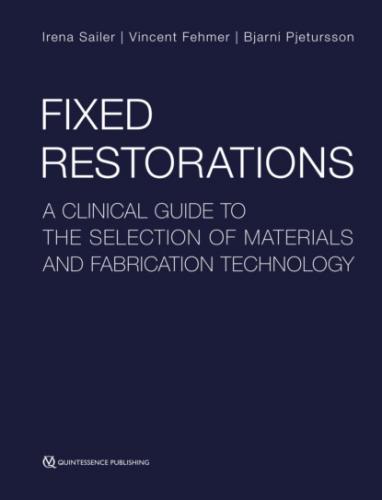Fixed Restorations. Irena Sailer
rel="nofollow" href="#ulink_a046b95b-6d7d-5c7a-9442-900bb20583f4">3. van Noort R. The future of dental devices is digital. Dent Mater 2012;28:3–12.
4. Schenk R. Biogeneric – another step closer to nature. Int J Comput Dent 2010;13:169–174.
5. Rengier F, Mehndiratta A, von Tengg-Kobligk H, et al. 3D printing based on imaging data: review of medical applications. Int J Comput Assist Radiol Surg 2010;5:335–341.
6. Cohen A, Laviv A, Berman P, Nashef R, Abu-Tair J. Mandibular reconstruction using stereolithographic 3-dimensional printing modeling technology. Oral Surg Oral Med Oral Pathol Oral Radiol Endod 2009;108:661–666.
7. Fehmer V, Muhlemann S, Hammerle CH, Sailer I. Criteria for the selection of restoration materials. Quintessence Int 2014;45:723–730.
8. Pjetursson BE, Sailer I, Zwahlen M, Hammerle CH. A systematic review of the survival and complication rates of all-ceramic and metal-ceramic reconstructions after an observation period of at least 3 years. Part I: single crowns. Clin Oral Implants Res 2007;18 Suppl 3:73–85.
9. Sailer I, Pjetursson BE, Zwahlen M, Hammerle CH. A systematic review of the survival and complication rates of all-ceramic and metal-ceramic reconstructions after an observation period of at least 3 years. Part II: fixed dental prostheses. Clin Oral Implants Res 2007;18 Suppl 3:86–96.
10. Vichi A, Ferrari M, Davidson CL. Influence of ceramic and cement thickness on the masking of various types of opaque posts. J Prosthet Dent 2000;83:412–417.
11. Kolakarnprasert N, Kaizer MR, Kim DK, Zhang Y. New multi-layered zirconias: composition, microstructure and translucency. Dent Mater 2019;35:797–806.
12. Elsaka SE. Optical and mechanical properties of newly developed monolithic multilayer zirconia. J Prosthodont 2019;28: e279–e284.
13. Kurbad A. Microveneering technique for esthetic enhancement of monolithic zirconia restorations. Int J Comput Dent 2016;19:165–178.
14. Tabatabaian F, Shabani S, Namdari M, Sadeghpour K. Masking ability of a zirconia ceramic on composite resin substrate shades. Dent Res J (Isfahan) 2017;14:389–394.
15. Bacchi A, Boccardi S, Alessandretti R, Pereira GKR. Substrate masking ability of bilayer and monolithic ceramics used for complete crowns and the effect of association with an opaque resin-based luting agent. J Prosthodont Res 2019;63:321–326.
16. Gwon B, Bae EB, Lee JJ, et al. Wear characteristics of dental ceramic CAD/CAM materials opposing various dental composite resins. Materials (Basel) 2019;12.
17. Zhang F, Spies BC, Vleugels J, et al. High-translucent yttria-stabilized zirconia ceramics are wear-resistant and antagonist-friendly. Dent Mater 2019;35:1776–1790.
18. Kontonasaki E, Rigos AE, Ilia C, Istantsos T. Monolithic zirconia: an update to current knowledge. Optical properties, wear, and clinical performance. Dent J (Basel) 2019;7: pii: E90.
19. Zarone F, Di Mauro MI, Ausiello P, Ruggiero G, Sorrentino R. Current status on lithium disilicate and zirconia: a narrative review. BMC Oral Health 2019;19:134.
In this chapter:
■ Esthetic parameters to be evaluated: step-by-step checklist
■ Time points for diagnostics, diagnostic tools
■ Conventional procedures
■ Digital procedures
■ Augmented reality in dentistry
■ Diagnostics for fixed implant-supported restorations, surgical stents
Pretreatment diagnostics is essential for predictable treatment outcomes in prosthodontics. Agreeing on the appearance of the final restoration in this early phase of the treatment is key to obtain satisfactory results in comprehensive restorative dentistry1–4.
Patients asking for an esthetic improvement of their dental appearance may approach the restorative team with a desired outcome in mind. Yet, the desired appearance can be difficult to achieve due to anatomical or other limitations. It is a challenge for the restorative team (ie, the dentist and dental technician) to determine the desired, yet realistic outcome for the patient before the initiation of restorative treatment.
Diagnostic wax-ups on the study casts and their transfer into the patient’s mouth using silicone indexes and autopolymerizing provisional resin (mock-up out of, eg, Protemp) are useful tools to clinically communicate and test the planned treatment outcome before the treatment.
The simulation of the final outcome helps with identifying the need for preprosthetic interventions, such as orthodontic tooth movement, or surgical procedures like crown lengthening and hard and/or soft tissue grafting. Furthermore, the diagnostic mock-up can serve as a guide for minimally invasive, defect-oriented tooth preparations.
Until recently, the pretreatment diagnostics encompassed the manual fabrication of a wax-up of the desired outcome on the study casts, and its transfer into clinics by means of a manually made resin mock-up. The major disadvantage of the conventional manually made wax-ups/mock-ups is that their fabrication is time-consuming, and in general only one version of the possible treatment outcome can be tested.
Contemporary digital technologies may provide advantageous features to the increase of efficiency of the pretreatment diagnostics. This Chapter reviews the esthetic parameters to be considered in the diagnostics, and the opportunities digital technologies offer in the diagnostic phase illustrating the procedures by means of one representative clinical example.
1.4.2 Esthetic parameters to be evaluated: step-by-step checklist
At the first examination of the patient, several aspects have to be considered as Part of the pretreatment diagnostics. The evaluation starts from the assessment of the general appearance of the patient, increasingly focusing on the details which are crucial for the restorative treatment. The following all-important aspects to be evaluated are listed next, in chronological order.
Facial aspect to be evaluated
■ Shape of the face – square, ovoid, tapered
